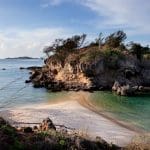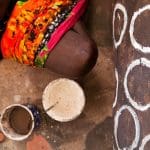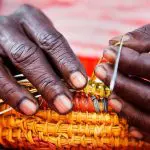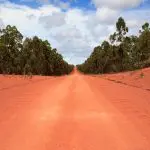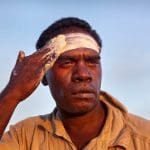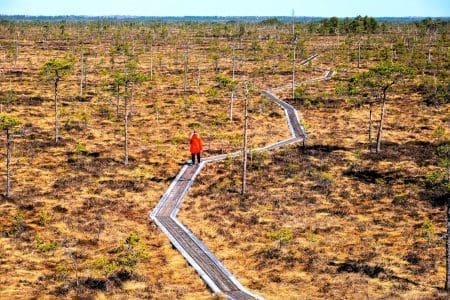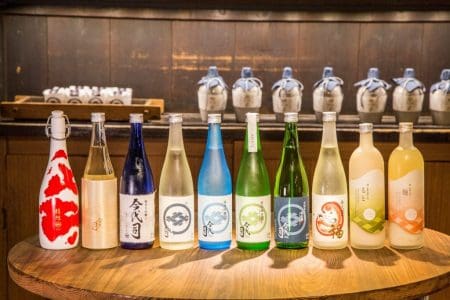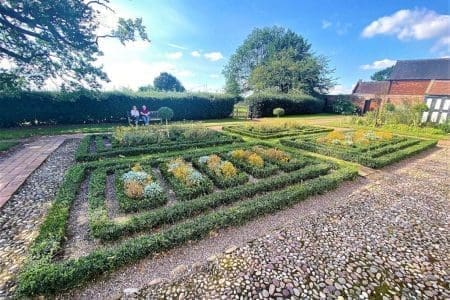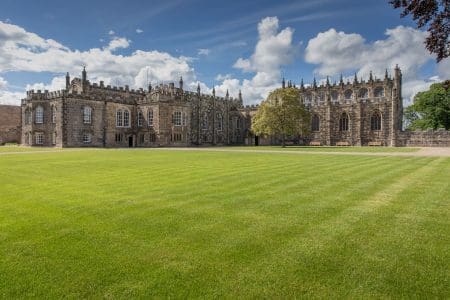Lynn Gail heads into the indigenous homelands in East Arnhem Land and experiences an unexpected connection to the land and its people.
The squelch from the sodden mud makes the only sound as I tread through land belonging to the world’s oldest living culture. From the surrounding bush a Yolngu man appears stealth like and starts tapping the ground in a rhythmic movement. His large, dark brown eyes bore into mine, and I feel exposed, stripped of my social shell as he crouches down, drumming the ground with a skinned branch. Young children, with faces covered in white tribal stripes, emerge from behind gum trees. They stomp in unison as rain drips from their long black eyelashes to a beat I cannot feel – it is something deeper – a more primal, tribal power.

Like a snap of the fingers the ritual is over, “welcome to our country, welcome to Nyinyikay,” they sing in chorus. An elder spreads damp white clay across my forehead, “welcome to this land, its people – where salt water and fresh water meet – this powerful and special clay welcome you to this land.”
It is a powerful moment, where two cultures with deeply different pasts, join to learn from each other.
Nyinyikay Homeland, East Arnhem Land
I have arrived at Nyinyikay Homeland, a small parcel of privately owned 92,000 hectares of Aboriginal land in East Arnhem Land, Northern Territory.
There is no electricity, no internet, no phone (apart from an emergency satellite one), and the last place with a till and something to buy was four hours ago, back where our plane had landed in Gove.
We had passed a solitary mud coated four-wheel drive while driving through bushland, stopping only for ‘bush breaks’ where some of the world’s deadliest creatures can finish you off faster than you can button up. Snakes, dingoes, spiders and wild buffalo all roam freely across the outback. With no GPS nor road signs, and where every tree and sandy track looked like the one before, I had asked Randy – our guide and driver – how he kept from following his own tail. He smiled, quoting an Aboriginal saying, “‘you’re never lost, you’ve not fallen from Earth, you’re merely disorientated’.”

Fresh summer rain is lifting heat from the dry soil as we enter Nyinyikay. We have arrived in Rarranhdharr season (September to October) when it is supposed to be hot and dry, but apparently an elder had recently passed away. The Yolngu believe the sudden downpour is his spirit returning to Earth.
As the skies begin to clear we head to the beach with Marcus Lacey, the man who had looked fixedly at me only an hour before. Two youngsters, Bruce and Peter, run down to join us and begin digging up shells. When opened, they reveal a tiny star, which the boys attach as earrings and giggle like little girls playing dress-ups.
Discovering about Yolngu Culture
I ask Marcus, a leading figure in the community, about his life as a schoolteacher for the indigenous children on Elcho Island, a short flight away. So much of their history is undocumented, and he explains the importance of passing their knowledge onto the younger generations. Stories, singing, and art forms such as dot paintings and drawings with detailed, intricate patterns are integral to preserving their history.

Two times runner-up of the Northern Territory Young Achiever Award, Marcus is passionate about building understanding between Yolngu and non-Yolngu people. His knowledge is extensive, and I ask if he will become an elder.
“I still have much to learn from the elders, and to gain respect from my family members,” he explains. Marcus is number 152 in the Gumatj clan, of which there are three groups.
As dusk approaches and warm air wraps around us, I learn Marcus is a respected painter who records his history in artwork he sells and exhibits. He explains every weather pattern, star, tide, plant and animal has meaning – everything above or below the ground is integral to their survival. The Yolngu know when to hunt certain animals when various plants flower, taking only what they need. When wattle is blossoming with masses of yellow flowers, it is time to hunt turtle. If clouds are drifting or rising over water and the sky is tinged orange, it is harvest day.
“There is a right time, a right season for all animals and plants to be used,” Marcus says. The land is their library, their university. They read it leaf by leaf, season by season.
Learning to Weave
Dusk is painting soft pink brush strokes across the setting sun. It feels as though roots are spreading through the souls of my feet, grounding me to this age-old spiritual land as I look across a silky ocean.

We settle around a campfire and share Dreamtime where Marcus and his family sing poignant ancestral songs in rhythmical tones. As the fire dwindles and darkness fills the light, I ask what time we will start in the morning. “Well,” Randy pauses, “there’s Sydney time, Victoria time, Western Australia and Queensland time,” he pauses, “then Northern Territory time,” another pause, I can just make out a wry smile in the embers, “then we have Yolngu time.” I head to my see-through tent, turn the alarm off, and drift into a deep sleep under a ceiling of soft, flickering stars.
In the morning, the women are gathering on a handwoven mat under a tree. They invite me to join them and share in ‘women’s’ business as they prepare a fire. We begin to boil and stir pandanus leaves used for weaving.
Nancy, a sprightly elder in her eighties, shows me how to stir the steaming pot of leaves with a long, thin pole. She spins them effortlessly, while it takes all my strength to start any spin at all. But what I lack in spin I clearly make up for in the entertainment stakes. The women cackle loudly at my fruitless efforts.
I have more success grinding the bright red root of the yirinanin grass plant, used for dye. As the women weave, they explain how Gurrutu (their network of kinship and relationships) is woven throughout each basket. The thread is significant in holding communities together, like an unseen glue, it binds them as one.
The Yirrita and Dhuwa
Under the tree I learn there are two moieties in Yolngu culture, Yirrita and Dhuwa. The landscape, stars, nature, weather, and all family members, belong to one of the two groups. Each moiety has its own set of mythologies, but they co-exist in Yolngu culture.

Rosemary, Marcus’s sister, explains Yolngu people cannot marry someone from the same moiety. A Yirrita person will marry a Dhuwa member, and vice versa. The child of a Yirrita mother is Dhuwa, the child of a Dhuwa mother, Yirrita. Seeing my confusion, Rosemary draws a fascinating, multilayered diagram in the sand to demonstrate the moieties. I sense it is the dumbed down cheat-sheet version, but it relays how important every relationship is in their belief system.
Nyinyikay Homeland, East Arnhem Land Photo Gallery
Bruce and Peter have returned from school and snuggle against me like I am part of the family. Rosemary hands them a bundle of blankets where a tiny head peeps through the folds. They have been nursing a joey back to health, only days old, the elders hunted the mother for food unaware of the baby in her pouch; but it is the circle of life here in the outback. Scared of breaking its delicate bones, the boys hold the joey like first-time fathers while feeding it milk through a baby’s bottle.
There is no city din, no background sound, apart from waves swishing gently at the water’s edge. It’s as though I’ve come home to a place I’ve never been as I sit with the world’s oldest living culture and feel a connection to something deeper, to a pull far below the Earth’s crusty surface.
If you have enjoyed Lynn’s tales in East Arnhem, then try her adventures with the Manggarai people on the Indonesian island of Flores, or Flying the Empty Coop on Tamborine Island.
Aboriginal Cultural Tours in East Arnhem Land
Lynn’s trip to East Arnhem Land was arranged through Lirrwi Tourism, an Aboriginal owned tour agency in North East Arnhem Land, Australia that operates Aboriginal cultural tours from Nhulunbuy and Gove. Unfortunately, 2020 tours are suspended due to COVID-19, but bookings are being taken for 2021.
Cover image: Storytime, Nyinikay, Gove, Northern Territory. All images by Lynn Gail.
